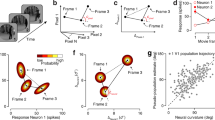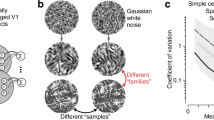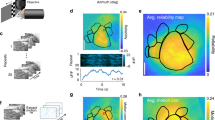Abstract
When an observer moves forward in the environment, the image on his or her retina expands. The rate of this expansion conveys information about the observer's speed1 and the time to collision2,3,4. Psychophysical5,7 and physiological8,9 studies have provided abundant evidence that these expansionary motions are processed by specialized mechanisms in mammalian visual systems. It is commonly assumed that the rate of expansion is estimated from the divergence of the optic-flow field (the two-dimensional field of local translational velocities)10,11,12,13,14. But this rate might also be estimated from changes in the size (or scale) of image features15. To determine whether human vision uses such scale-change information, we have synthesized stochastic texture stimuli in which the scale of image elements increases gradually over time, while the optic-flow pattern is random. Here we show, using these stimuli, that observers can estimate expansion rates from scale-change information alone, and that pure scale changes can produce motion after-effects. These two findings suggest that the visual system contains mechanisms that are explicitly sensitive to changes in scale.
This is a preview of subscription content, access via your institution
Access options
Subscribe to this journal
Receive 51 print issues and online access
$199.00 per year
only $3.90 per issue
Buy this article
- Purchase on Springer Link
- Instant access to full article PDF
Prices may be subject to local taxes which are calculated during checkout




Similar content being viewed by others
References
Clifford, C. W., Beardsley, S. A. & Vaina, L. M. The perception and discrimination of speed in complex motion. Vision Res. 39, 2213–2227 (1999).
Lee, D. N. A theory of visual control of braking based on information about time-to-collision. Perception 5, 437–459 (1976).
Schiff, W. & Detwiler, M. L. Information used in judging impending collision. Perception 8, 647–658 (1979).
Kaiser, M. K. & Hecht, H. Time-to-passage judgments in non-constant optical flow fields. Percept. Psychophys. 57, 817–825 (1995).
Regan, D. & Beverley, K. I. Illusory motion in depth: aftereffect of adaptation to changing size. Vision Res. 18, 209–212 (1978).
Regan, D. & Beverley, K. I. Binocular and monocular stimuli for motion in depth: changing-disparity and changing-size feed the same motion-in-depth stage. Vision Res. 19, 1331–1340 (1979).
Morrone, M. C., Burr, D. C., Di Pietro, S. & Stefanelli, M. Cardinal directions for visual optic flow. Curr. Biol. 9, 763–766 (1999).
Orban, G. A. et al. First-order analysis of optical flow in monkey brain. Proc. Natl Acad. Sci. USA 89, 2595–2599 (1992).
Duffy, C. J. & Wurtz, R. H. Sensitivity of MST neurons to optic flow stimuli: I. a continuum of response selectivity to large-field stimuli. J. Neurophysiol. 65, 1329–1345 (1991).
Gibson, J. J. The Perception of the Visual World (Houghton Mifflin, Boston, 1950).
Warren, W. H., Morris, M. W. & Kalish, M. L. Perception of translational heading from optical flow. J. Exp. Psychol. Hum. Percept. Perform. 14, 646–660 (1988).
Warren, W. H., Blackwell, A. W., Kurtz, K. J., Hatsopoulos, N. G. & Kalish, M. L. On the sufficiency of the velocity field for perception of heading. Biol. Cybern. 65, 311–320 (1991).
Perrone, J. A. Model for the computation of self-motion in biological systems. J. Opt. Soc. Am. A 9, 177–194 (1992).
Crowell, J. A. & Banks, M. S. Perceiving heading with different retinal regions and types of optic flow. Percept. Psychophys. 53, 325–337 (1993).
Beverley, K. I. & Regan, D. Texture changes versus size changes as stimuli for motion in depth. Vision Res. 23, 1387–1400 (1983).
Anstis, S. M. The perception of apparent movement. Phil. Trans. R. Soc. Lond. B 290, 153–168 (1980).
Cavanagh, P. & Mather, G. Motion: the long and short of it. Spatial Vis. 4, 103–129 (1989).
Blake, R. & Hiris, E. Another means for measuring the motion aftereffect. Vision Res. 33, 1589–1592 (1993).
Perrone, J. A. Anisotropic responses to motion toward and away from the eye. Percept. Psychophys. 39, 1–8 (1986).
Tyler, C. & Sutter, E. Depth from spatial frequency difference: An old kind of stereopsis? Vision Res. 19, 859–865 (1979).
Tian, R. & Rauschecker, J. P. Processing of frequency-modulated sounds in the cat's posterior auditory field. J. Neurophysiol. 79, 2629–2642 (1998).
Watson, A. B. & Pelli, D. G. Quest: A Bayesian adaptive psychophysical method. Percept. Psychophys. 33, 113–120 (1983).
Kendall, M. K. & Stuart, A. The Advanced Theory of Statistics: Vol. 3. Design, Analysis, and Time Series (Hafner, New York, 1966).
Acknowledgements
This work was begun when all three authors were at the University of Pennsylvania. P.S. was supported by a training grant from the NEI at the University of Pennsylvania and by a research grant from the NIH at the University of Minnesota; E.S. was supported by the National Science Foundation and the Alred P. Sloan Foundation; and D.K. was supported by a research grant from the NIH.
Author information
Authors and Affiliations
Corresponding author
Rights and permissions
About this article
Cite this article
Schrater, P., Knill, D. & Simoncelli, E. Perceiving visual expansion without optic flow. Nature 410, 816–819 (2001). https://doi.org/10.1038/35071075
Received:
Accepted:
Issue Date:
DOI: https://doi.org/10.1038/35071075
Comments
By submitting a comment you agree to abide by our Terms and Community Guidelines. If you find something abusive or that does not comply with our terms or guidelines please flag it as inappropriate.



